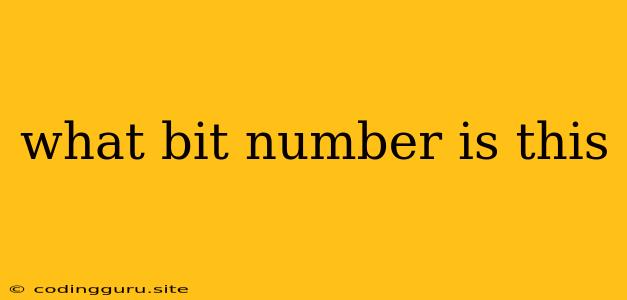What Bit Number is This? A Comprehensive Guide to Understanding Binary
Have you ever looked at a string of 1s and 0s and wondered, "What bit number is this?" The world of computing hinges on binary, a system of representing information using only two digits: 0 and 1. Understanding how these bits are numbered is crucial for tasks like debugging code, working with memory addresses, and even comprehending how computers operate.
The Basics of Binary Representation
Binary, as its name suggests, uses a base-2 system. Think of it like counting in decimal (base-10) but with only two digits. Each position in a binary number represents a power of 2.
Let's break down a simple example:
1011<sub>2</sub>
- The rightmost bit (1) is in the 2<sup>0</sup> position, which is equivalent to 1.
- The next bit to the left (1) is in the 2<sup>1</sup> position, which is equivalent to 2.
- The next bit to the left (0) is in the 2<sup>2</sup> position, which is equivalent to 4.
- The leftmost bit (1) is in the 2<sup>3</sup> position, which is equivalent to 8.
To convert this binary number to decimal, we add up the values represented by each bit: 1 + 2 + 0 + 8 = 11.
Determining Bit Numbers
Now, let's tackle the core question: "What bit number is this?" This refers to identifying the positional value of a specific bit within a binary representation.
For instance, consider the binary number 1011001:
- What is the bit number of the rightmost 1? It's in the 2<sup>0</sup> position, which is bit 0.
- What is the bit number of the leftmost 0? It's in the 2<sup>6</sup> position, which is bit 6.
Key Takeaway: Bit numbering starts from 0 at the least significant bit (LSB) and increases towards the most significant bit (MSB).
Why Is This Important?
Understanding bit numbering has several practical applications:
- Working with Memory Addresses: In computer memory, each byte (8 bits) has a unique address. Bit numbering helps us pinpoint specific bits within that address.
- Analyzing Error Codes: Error codes often convey information through specific bits. Knowing the bit number helps us interpret the error message.
- Debugging Code: When debugging, it's common to examine data structures at the bit level. Bit numbering helps us track individual bits and their influence.
- Data Communication Protocols: Many communication protocols rely on specific bit patterns for signaling purposes.
Practical Tips
- Visualizing Bits: It can be helpful to imagine the binary number as a series of boxes, each holding a 0 or 1. Number these boxes from right to left, starting at 0.
- Converting to Decimal: When in doubt, convert the binary number to decimal. This can make identifying the position of a particular bit easier.
- Using Tools: There are online calculators and tools specifically designed to work with binary numbers. These can help you quickly determine bit numbers and perform other calculations.
Conclusion
Knowing "what bit number is this" is essential for anyone working with binary data or understanding how computers function. It allows us to interpret data, troubleshoot issues, and gain a deeper understanding of the underlying mechanisms at play.
